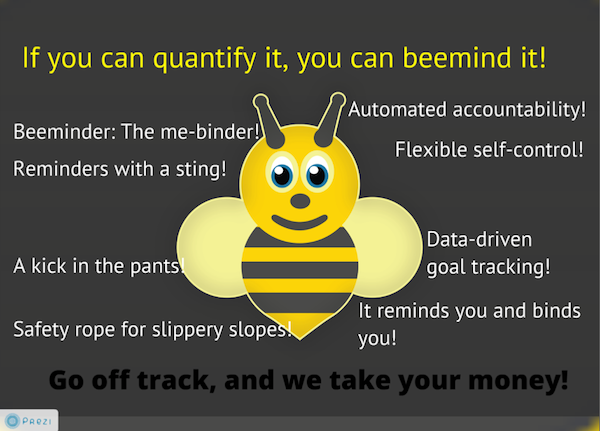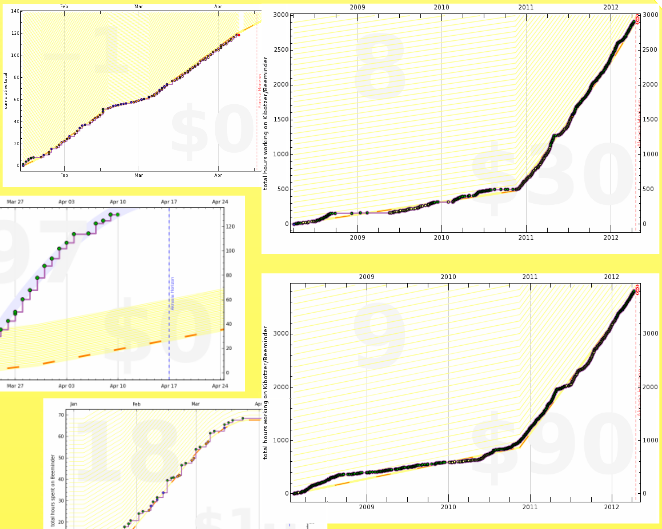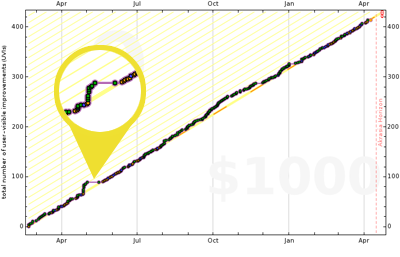
[The Beeminder founders, Bethany Soule and Daniel Reeves, presented at the Portland Quantified Self Meetup on April 10. This is what they said.]
We’re excited to be here! We used to go to Quantified Self meetups in New York and we just moved here, to pursue the Portlandian Dream of working a couple hours a week in a coffee shop and going to clown school. [They hate it when you say that.] Actually it was to join the Portland Seed Fund and work on our awesome Quantified Self startup which we are totally not here to pitch!

Rather, this is about beeminding the building of Beeminder, which means showing you graphs of things like the 7000 person-hours we’ve spent working on this. (Technically 6986 and counting. Pitching Beeminder totally counts.) [Remember, we’re not pitching!]
“Bethany concocted what she dubbed the Voluntary Harassment Program to keep me churning out chapters.”
Right, so the self-quantifying journey that is Beeminder begins in 2005 when I was scrambling to get my PhD thesis written and Bethany, who I had recently met and, obviously, fallen head-over-heels for, concocted what she dubbed the Voluntary Harassment Program to keep me churning out chapters. That was a smashing success and we continued to experiment on ourselves with crazy incentive schemes and productivity hacks until 2008 when we started getting friends and family in on the fun, with what we called Kibotzer — the kibitzing robot — which was an early incarnation of Beeminder, and the point where those 7000 person-hours started.
We had read a Paul Graham essay about startups called “How Not to Die” in which he suggests that if you could just fully commit yourself to not giving up, your chances of success would be 90%, which he emphasizes he’s being perfectly serious about. [1]
So we were like “We have an app for that!”. And we started tracking our time — which we had written a nifty time tracker for called TagTime, which this is also not a pitch for (in fact it’s not exactly user friendly — it requires cloning a git repository and working knowledge of vim) — but it is super awesome and integrates with Beeminder and these graphs were generated automatically from that data.

We got up to 2000 person-hours or so and we still weren’t publicly launched, our beta users couldn’t create new goals without going through an admin interface, and it was seriously tempting to throw in the towel and get a real job. The only interesting thing we learned was that 40 hours of work per week is damn hard when you’re only counting actual work. We were also reminded of the adage “You make what you measure”.
“We committed to averaging one User-Visible Improvement to Beeminder per day.”
So we decided to commit ourselves to visible inexorable forward progress. In February of 2011 we committed to averaging one User-Visible Improvement to Beeminder per day. (We made that public in a blog post a couple months later.) We call them UVIs. If we failed — if we were ever off-track as measured by our meta Beeminder road — we’d pay a user [Dr Evil pose] $1000.
I actually pushed back hard about this when Danny first suggested it. It was a scary prospect, and seemed like it was potentially problematic. What about refactoring (not user visible), writing tests (not user visible)? What if I needed to work on some bigger feature that couldn’t be rolled out in bits and pieces?
But finally, upon reassurances that we could pick arbitrarily small things to tweet, and the pretty stark reality that we weren’t getting the right things done without the commitment, I agreed.
“The UVI road may have literally saved Beeminder”
So how did this new focus change things? How has it affected Beeminder’s growth? First, there’s more than one time when the UVI road may have literally saved Beeminder. In May of 2011 we had a huge family reunion (on a boat). It was nearly three weeks of travel, and we built up a huge safety buffer of UVIs to get us through.

But you know how it is after a family vacation. You need a vacation from your vacation. And when your job is coding, it’s even harder to get back to work after three weeks away — you have to load all that code back into your head. We actually had a UVI due on one of the first couple days back. We had to get to work (to the tune of $1000).
We realize this is not a direct correlation with success, but we think there are a lot of positive ways it has shaped us as we’ve grown. Our company has become one where the focus is on making our users happier every single day (on average!). Our customers are really ecstatic about that. Which makes them shockingly happy to pay us when they go off track. Of course, we track a lot more than just UVIs and time. [2] Which you can now ask about if anything particular jumps out at you!
Following are our somewhat tongue-in-cheek slides, also viewable on Prezi:
Footnotes
[1] Another apt quote from that essay: “Startups rarely die in mid keystroke. So keep typing!”
[2] Our UVI meta road may have saved Beeminder, but it’s beyond all doubt that our blog meta road has kept our blog from petering out. (Whenever you see someone skating the edge of their yellow brick road it’s a sure sign that Beeminder can take credit for some of the output.)